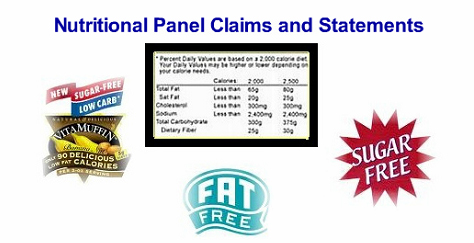
What and How Claims and Statement are Written?
The Claims and Statement section was created for the use of additional nutrient content claims on labels in accordance with provisions of the Nutrition Labeling and Education Act of 1990.
Click here to go directly to that subject.
[Antioxidant] [Fiber] [Sugar Free] [Fat Free] [Descriptive Terms] [Disclosure]
- Antioxidant: An antioxidant nutrient content claim can only be made for nutrients for which there is an established RDI.
- Note: The antioxidant nutrient must meet the requirements for nutrient content claims for High claims, Good source claims, and More claims, respectively (in 21 CFR 101.54(b),(c),or(e)).
- Example: To use a high claim, the food would have to contain 20% or more of the Daily Reference Value (DRV) or RDI per serving. For a good source claim, the food would have to contain between 10-19% of the DRV or RDI per serving.
- Example of correct usage: "high in antioxidant vitamins C and E"
- Fiber: You can use "high", "good source" or "more". However; if the food is NOT "low" in total fat, then the label must include the level of total fat per labeled serving.
- Sugar Free: food that contains less than 0.5 g of sugars. Terms such as "free of sugar", "no sugar", "zero sugar", "without sugar", "sugarless", "trivial source of sugar", "negligible source of sugar", "dietarily insignificant source of sugar" can also be used. However; If the food is NOT also low or reduced in calorie that fact must be disclose.
- Fat Free: food contains less than 0.5 grams fat per serving. RAW serving. 3
- Descriptive Terms: Each term can only be used if the nutrient it refers to is contained in the food product at a minimum percentage or above.
- "high potency": food contains 100 percent or more of vitamins or minerals (RDI). Example of correct usage: "Botanical X with high potency vitamin E."
- "more", "fortified", "enriched", "added", "extra", and "plus" : food contains at least 10 percent more of the RDI. Used in the description of protein, vitamins, minerals, dietary fiber, or potassium.
- "rich in", or "excellent source of": food contains 20 percent or more of the RDI or the DRV.
- "good source", "contains", or "provides": food contains 10 to 19 percent of the RDI or the DRV.
- "light" can be used only if the consumer would generally recognize it as a food that is improved in its nutrient value compared to other average products of its type.
- "reduced", "less", "fewer" , and "light" : the label must state each of the following (these are called "accompanying information"):
- The percentage or fraction by which the food has been modified,
- The reference food, and
- The amount of nutrient (that is the subject of the claim) that is in the labeled food and in the reference food.
What is a Disclosure Statement?
Disclosure statement "... is a statement that calls the consumer's attention to one or more nutrients in the food that may increase the risk of a disease or health-related condition that is diet related. The disclosure statement is required when a nutrient in a food exceeds certain prescribed levels."
"...disclosure statement is required when a NCC is made and the food contains one or more of the following nutrients in excess of the levels listed below per Reference Amount Customarily Consumed (RACC), per labeled serving, or, for foods with small serving sizes, per 50 grams."
| Total Fat | 13.0 grams |
| Saturated Fat | 4.0 grams |
| Cholesterol | 60 milligrams |
| Sodium | 480 milligrams |
